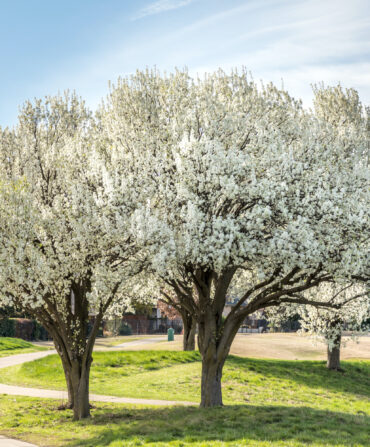At first glance, the jumble of vine-covered wood outside of Capers Landrum Cauthen’s modest workshop appears good for hiding fire ants and rattlesnakes, and that’s about it. It’s not until you step, gingerly, into the stack’s perimeter that Cauthen reveals the treasure hidden in plain sight: a slab of thousand-year-old black cypress bearing the swirling cut marks of a long-defunct sawmill. “And this is an old fence post from Gun Bluff Plantation out on Edisto Island,” the forty-two-year-old owner of Landrum Tables says, brandishing a four-inch-thick column that will soon be shorn into four fine Hepplewhite legs. “See that rough, crazy-looking old piece over there? Horses chewed on it. That will become the skirt of a coffee table.”

Photo: Ben Williams
From consoles to kitchen islands, each one-of-a-king Landrum table takes its design cues from the patina and history of the reclaimed wood.
In the few short years since Cauthen set his saw blade buzzing on James Island, South Carolina, a few miles from downtown Charleston, his reclaimed wood tables have become sought-after design objects across the South. His client list is as diverse as his woodpile—from interior designer Amelia Handegan, who commissioned a kitchen island for her 1940s beach bungalow, to chef Mike Lata, whose FIG restaurant features a pedestal table made from antique beaded oak casing, to preservation-minded home owners who want to do a bit of creative recycling. Cauthen has constructed more than fifty tables from rafters, beams, and panels taken from the houses in which they now reside.

Photo: Ben Williams
A carpenter’s clamp.
Because each piece of wood is different, each Landrum table is unique. Some look as if they could have been built in 1850. Others carry more modern touches such as stainless steel tops or sink fixtures. Almost all bear scars from a past carpenter’s chisel or the teeth of the two-man, two-handled pit saws once favored by Southern loggers. “Those imperfections are where the beauty lies,” Cauthen says. “When I started this, I knew that if I was going to reclaim wood and maintain the old characteristics—the nails, the cut marks—I had to build tables that fit the time period of the wood, too. It’s real distressed, instead of faux distressed like something out of a catalog.”
Making tables is not a business Cauthen planned. He fell into it—literally and figuratively. Four years ago, he suffered a freak skateboarding accident that left him missing several teeth and unable to write or speak. Shortly thereafter, he dreamed up his first table. “They say a head injury opens up different parts of your mind, to keep things working,” he says. “So this—the inspiration—really came about from the worst part of my life.”

Photo: Ben Williams
Finished tables ready for new homes.
But Cauthen began honing his craft long before then. His late father, Henry, was an antiques dealer and the longtime director of the Preservation Society of Charleston, and he instilled in his son a deep and abiding appreciation for design. Cauthen learned early how to tell not only a home’s architectural history, but also the history of its furniture. He apprenticed with master carpenters and helped repair and restore some of Charleston’s oldest homes, particularly after Hurricane Hugo in 1989. There was only one aspect of the renovation work that bothered him: He couldn’t stand to see centuries-old wood burned or sent to the landfill. The way he saw it, ancient cypress, oak, or pine might contain sections of rot at the ends, rendering the wood useless as a building material, but still be formidably dense and solid in the middle, making it perfect for furniture—if it could be saved.
These days, there’s no shortage of material to work with, thanks to Cauthen’s growing reputation. Fellow carpenters and renovators donate their cast-off wood. They also call him if they see a promising stack in a rural burn pile or sitting on the roadside. Clients do, too. During a recent trip to Eatonton, Georgia, Chuck Haley, president of the Peoples Bank of Eatonton, put Cauthen onto a series of turn-of-the-century warehouses scheduled for demolition. They proved an astonishing trove of virgin heart pine, with thick floor panels and roof beams twenty feet long.

Photo: Ben Williams
A guiding sketch.
Back in his shop, Cauthen slides a timeworn Red Devil scraper with a long homemade handle along the top of a fat two-hundred-year-old plank. With each stroke, the wood’s crumbling turquoise paint dissolves into a fine powder that disappears into the steady breeze. “I like to leave a little bit of paint in there for the patina,” he says. “Lately, I’m also getting crazy about driftwood. I found this old piece in the marsh with rusty bolts in it.” As his voice trails off, he’s already envisioning his next table, bolts and all.
For more information, go to landrumtables.wordpress.com








